
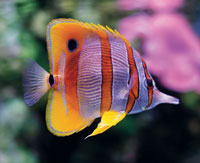 The copper-banded butterflyfish (Chelmon rostratus) can help control Aiptasia, but there may be better options.
The copper-banded butterflyfish (Chelmon rostratus) can help control Aiptasia, but there may be better options.
Q. Aiptasia have totally taken over my reef aquarium! Aiptasia are growing in the overflow, on the aquarium walls in the refugium, and all over the live rock. There is so much Aiptasia throughout the reef aquarium that my coral polyps are staying retracted and my clams won’t open up because the little anemones are all over their shells – hitting their mantles. When I asked the attendant at my tropical fish retailer for advice he recommended a copper-banded butterflyfish (Chelmon rostratus) to control the outbreak.
Will the copper-banded butterflyfish take care of my Aiptasia problem and allow my corals to flourish again? Is there anything that will rid an aquarium of these pesky anemones?
Justin Fike
Delaware
A. You are not alone in your battle against Aiptasia. They can be annoying and potentially devastating pests in reef aquariums. Oddly, those who keep fish-only aquariums often don’t mind Aiptasia anemones because they don’t really harm the tropical fish and add some invertebrate life to the reef aquarium. Though, as you mentioned, on the reef aquarium front they can be very destructive because they can agitate corals and clams, sometimes leading to their demise. What makes Aiptasia particularly infuriating is that they are so tough to eradicate. I have heard from countless hobbyists who go as far as scrubbing live rock with a course toothbrush to remove Aiptasia. Days later the hobbyist finds two or three Aiptasia where there was once only one.
Physically removing these tiny tissue-based animals is nearly impossible. As soon as you try to nip, scrub, or snap off Aiptasia anemones, they quickly withdraw into even the tiniest crevice or hole. It also appears that any flesh left behind will in time just grow another anemone and some hobbyists believe that spreading the flesh around while scrubbing causes the Aiptasia to multiply.
It is tough to recommend a copper-banded butterflyfish as a control measure for Aiptasia. Oftentimes copper-banded butterflyfish will rid a reef aquarium of all Aiptasia anemones then refuse to eat anything else and perish shortly after. Some hobbyists have compared the copper-banded butterflyfish’s dismal survival rate to that of the Moorish idol because many of the fish imported into retailers perish within months of introduction into the reef aquarium. While I am nearly certain the copper-banded butterflyfish would correct your Aiptasia problem, its unlikely chance of surviving in the reef aquarium removes it from the list of realistic remedies.
Hobbyists often have better results using raccoon butterflyfish (Chaetodon lunula). These tropical fish generally eat well in captivity and are reasonably hardy though it is not above them to make a total meal out of coral polyps and beneficial anemones. I have heard that raccoon butterflyfish are far more aggressive coral eaters than the copper-banded butterflyfish, so bad in fact that most hobbyists do not consider them reef safe.
Your best bet at a biological control comes in the form of the inexpensive and easily kept red-legged or hairy hermit crab (Dardanus megistos). These small crabs are reef safe and normally one or two per infested reef aquarium is all that it takes to help control Aiptasia outbreaks. Remember that these crabs are small so don’t expect stellar results overnight. It will take the little hermits some time to start making a real impact against the Aiptasia. The peppermint shrimp (Lysmata wurdemanni) is another gallant warrior in the never ending fight against Aiptasia. These small shrimp (when kept in groups) can make quick work of an Aiptasia outbreak though are reported to occasionally nibble on coral polyps.
My recommendation is the use of red-legged hermit crabs in conjunction with the use of a small colony (3 to 5) of peppermint shrimp. I think between the shrimp and crabs your Aiptasia issue will get cleared up and you won’t be left with an animal that then refuses to eat and eventually perishes or uses your reef aquarium as a giant buffet.
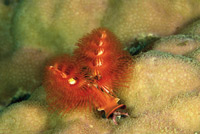 Aiptasia
Q. I have Aiptasia all over my aquarium and have been
Aiptasia
Q. I have Aiptasia all over my aquarium and have been
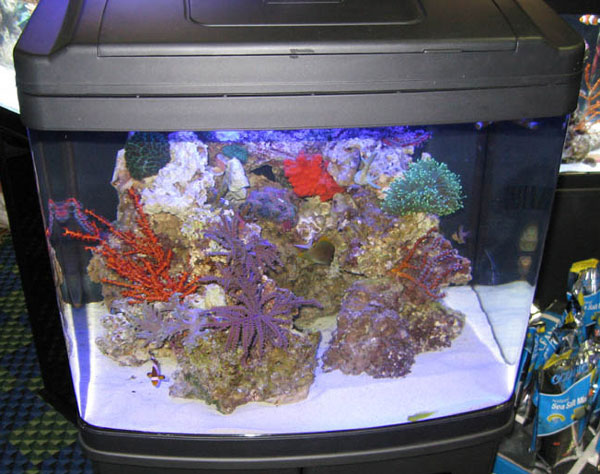 Marine Nano Tank Problems
Marine Nano Tank Problems
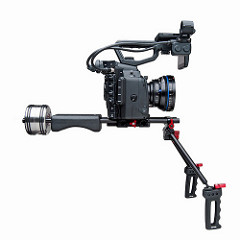 Catch More Salmon - Follow These Simple To Implement Techniques
FLAT Rigs outriggers, shock cord snubber, and rigging kit i
Catch More Salmon - Follow These Simple To Implement Techniques
FLAT Rigs outriggers, shock cord snubber, and rigging kit i
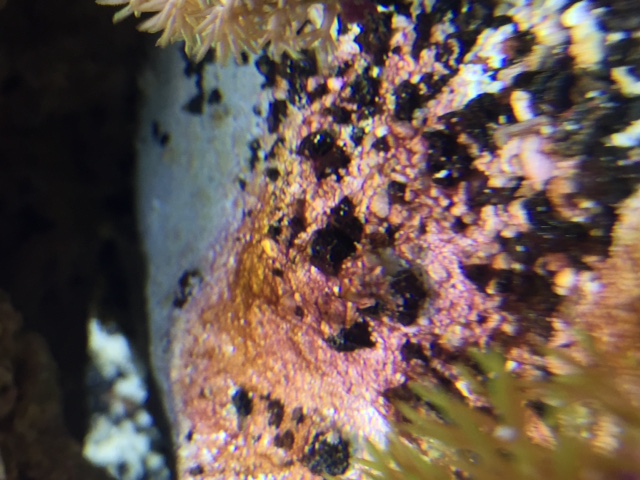 Red Algae in Marine Aquarium
Q. Ive been keeping saltwater fish for about five years, and
Red Algae in Marine Aquarium
Q. Ive been keeping saltwater fish for about five years, and
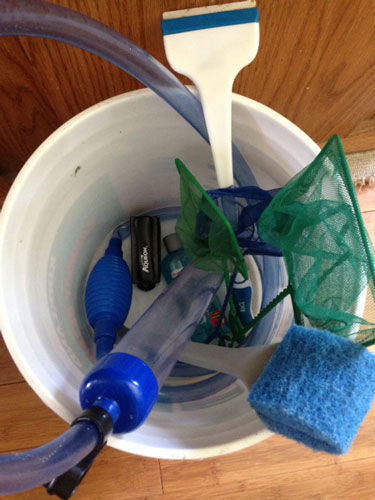 What to Keep in Your Aquarium Maintenance Bucket
It is too easy for hobbyists, especially new ones, to become
What to Keep in Your Aquarium Maintenance Bucket
It is too easy for hobbyists, especially new ones, to become
Copyright © 2005-2016 Pet Information All Rights Reserved
Contact us: www162date@outlook.com